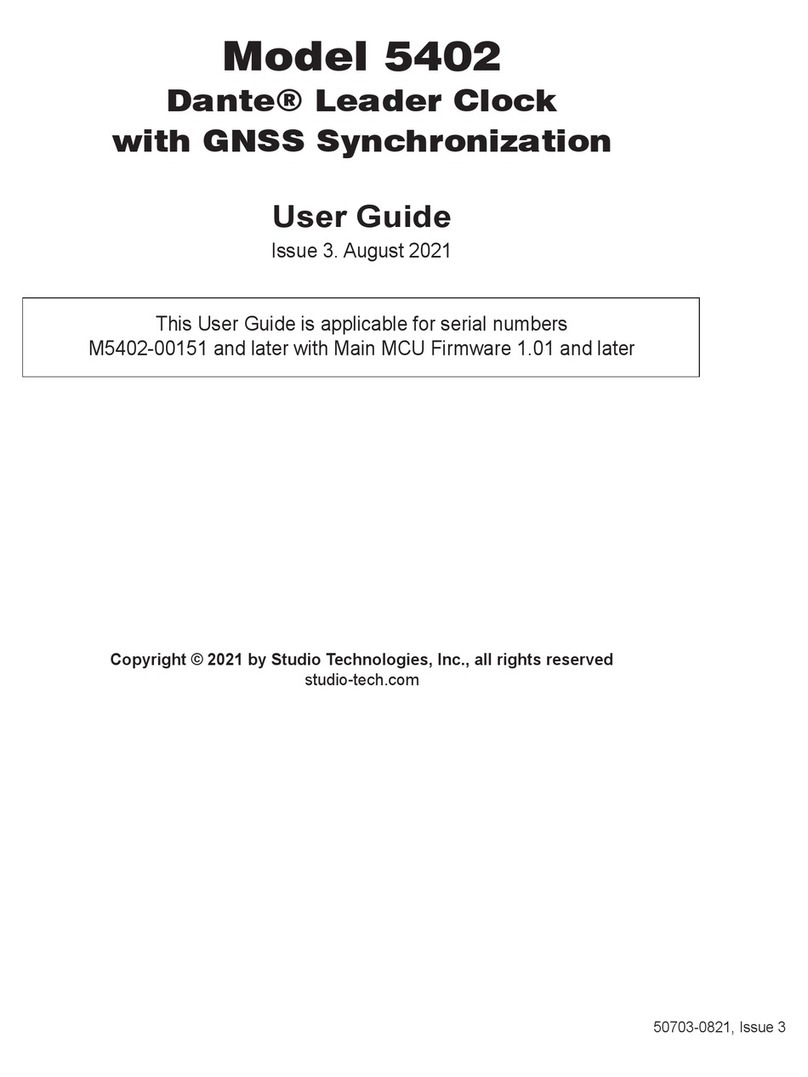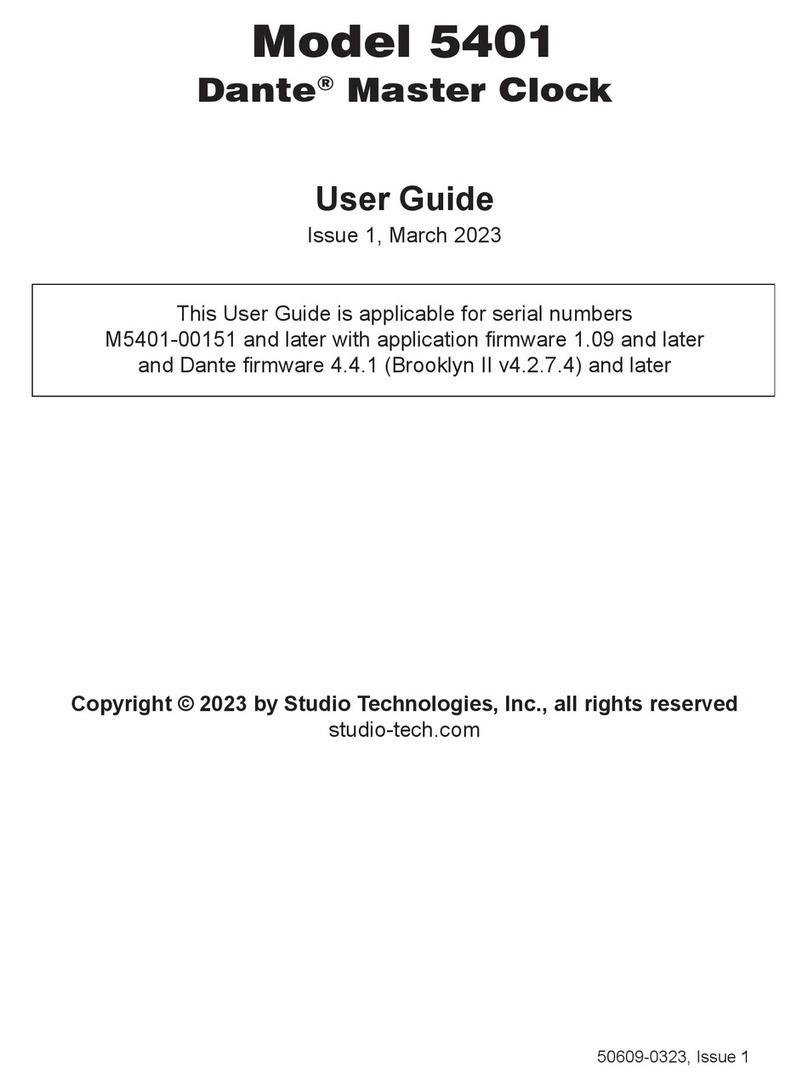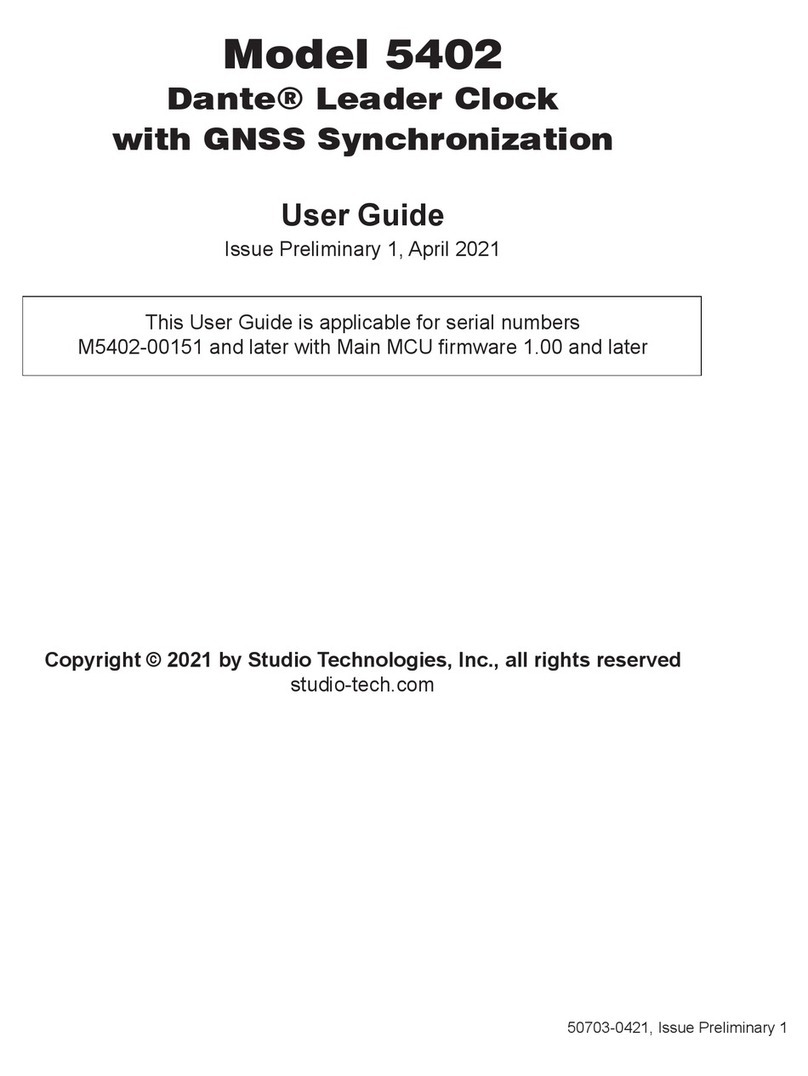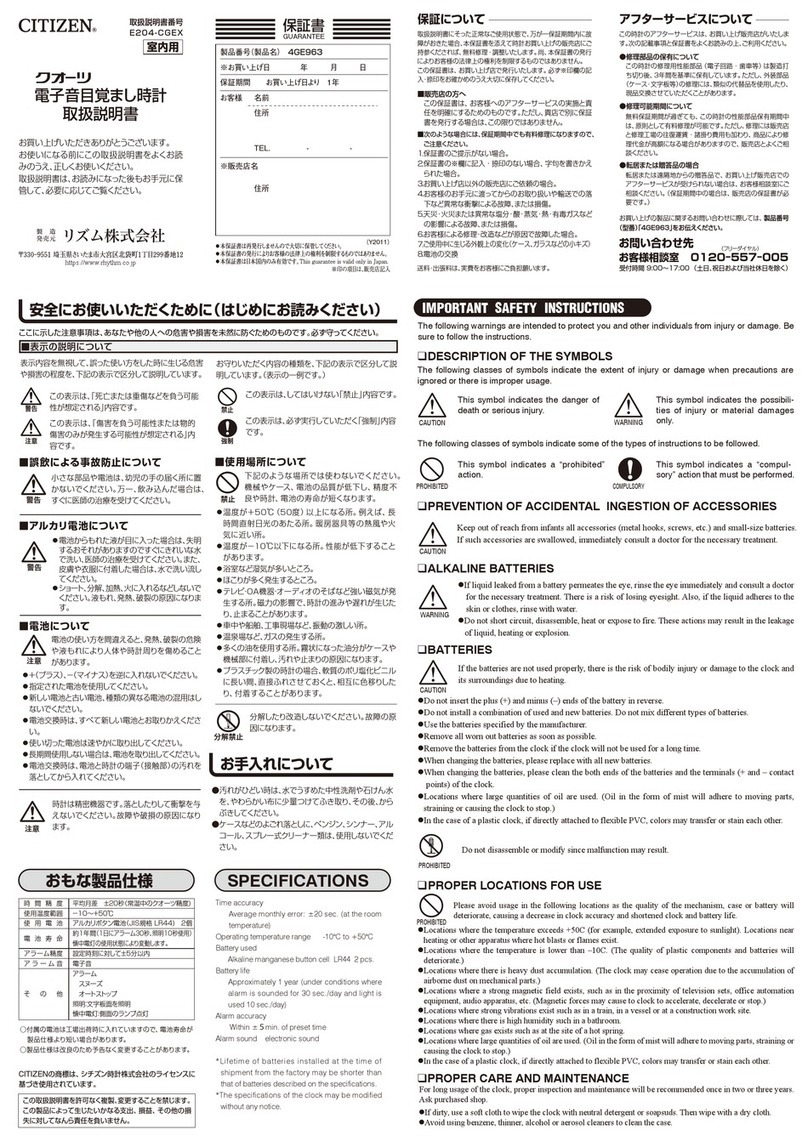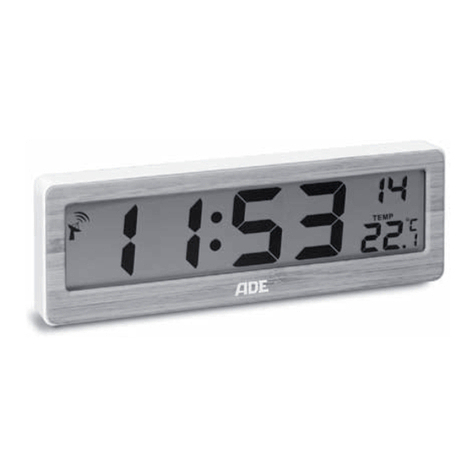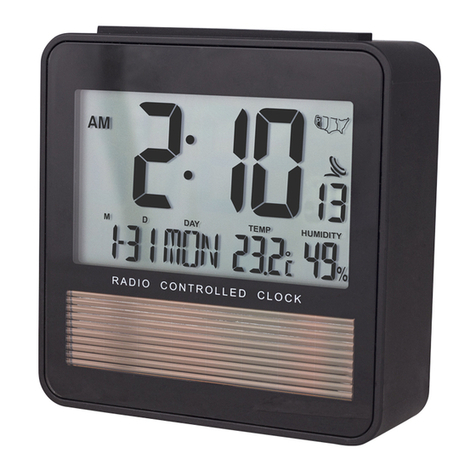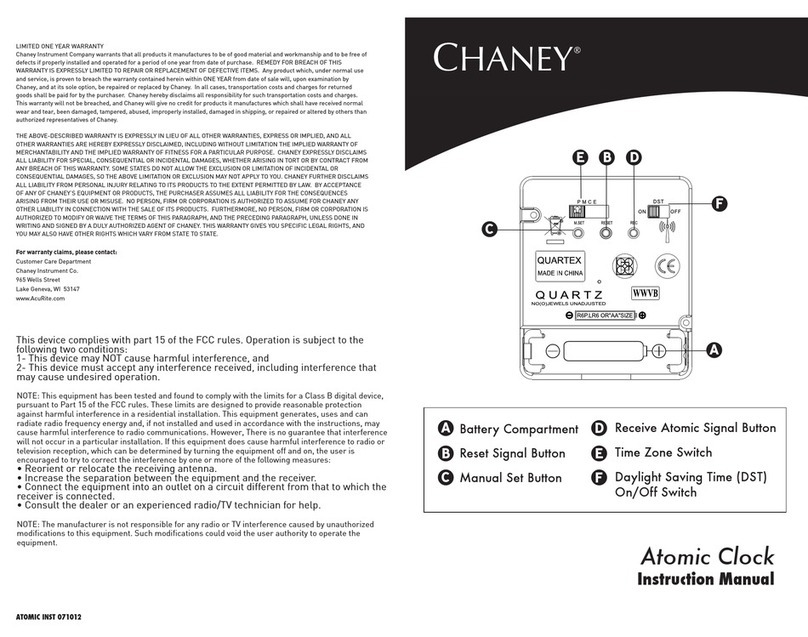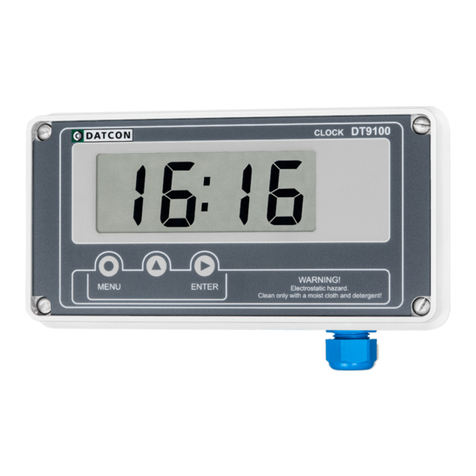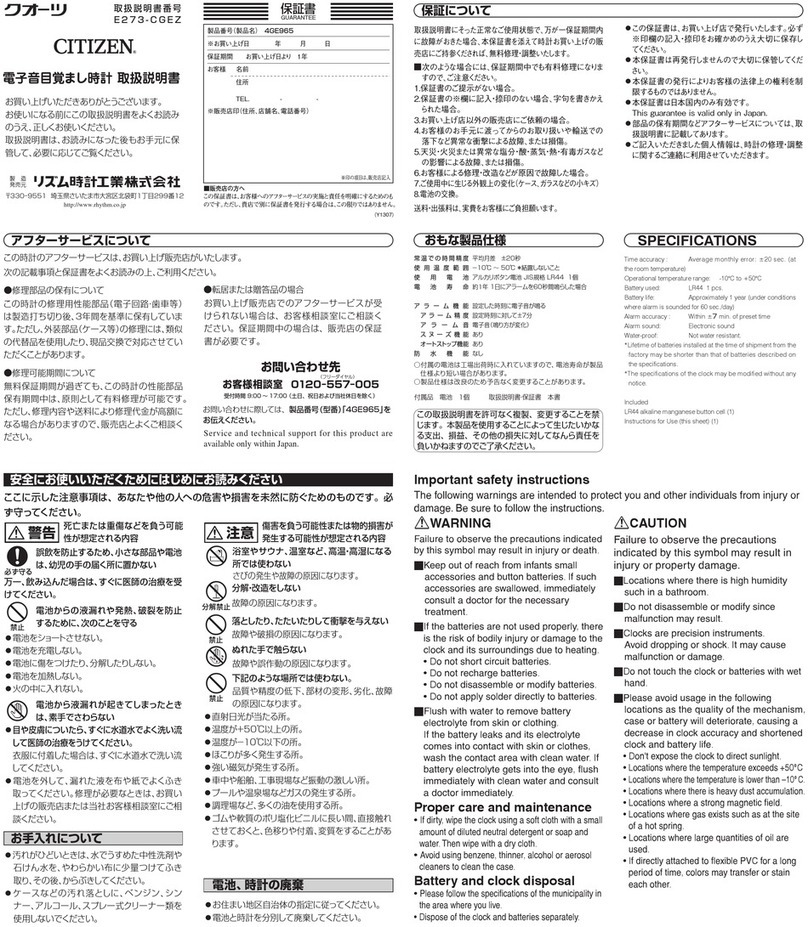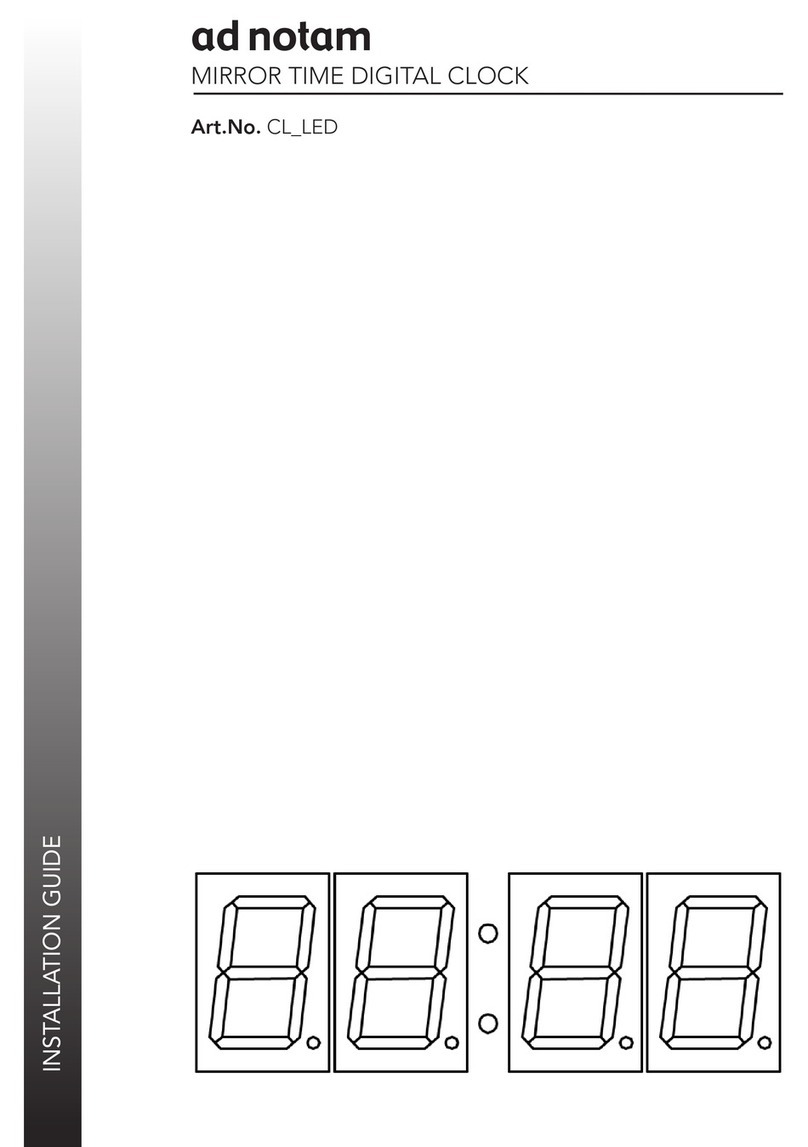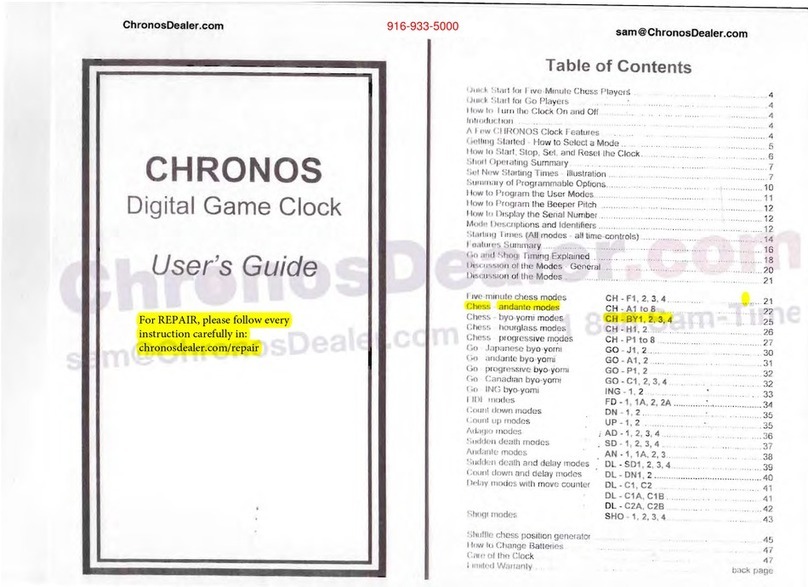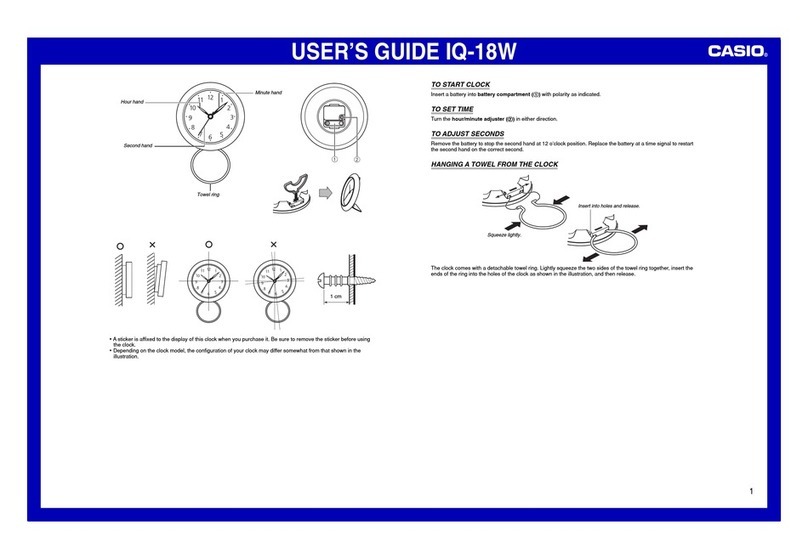Studio Technologies 5401A User manual

50701-0421, Issue Preliminary 2
Copyright © 2021 by Studio Technologies, Inc., all rights reserved
studio-tech.com
User Guide
Issue Preliminary 2, April 2021
This User Guide is applicable for serial numbers
M5401A-01001 and later with Main MCU firmware 1.02 and later
Model 5401A
Dante® Leader Clock

This page intentionally left blank.

Model 5401A User Guide Issue Preliminary 2, April 2021
Studio Technologies, Inc. Page 3
Table of Contents
Revision History ........................................................... 4
Introduction ................................................................... 5
Installation .................................................................... 9
Dante Configuration .....................................................13
Model 5401A Configuration ..........................................15
Operation ......................................................................30
Technical Notes ............................................................41
Specifications ...............................................................46
Appendix A–Network Configuration Examples .............48
Appendix B–Sync Input Sources ..................................51
Appendix C–Dante Controller Network Default
Configuration Values ....................................................52
Appendix D–Menu Structure ........................................53
Appendix E–Screen Captures ......................................54
Appendix F–Model 5401A’s Default Configuration
Values ...........................................................................58
Appendix G–PTP v2 (IEEE-1588-2008)
Characteristics ..............................................................59
Appendix H–Accessing the Unit when the
User Name and/or Password is Not Known .................60

Issue Preliminary 2, April 2021 Model 5401A User Guide
Page 4 Studio Technologies, Inc.
Revision History
Issue Preliminary 2, April 2021:
• Minor corrections and clarifications.
Issue Preliminary 1, April 2021:
• Initial preliminary release.

Model 5401A User Guide Issue Preliminary 2, April 2021
Studio Technologies, Inc. Page 5
Introduction
The Model 5401A Dante Leader Clock pro-
vides precise timing signals for applications
that utilize the Dante audio-over-IP media
networking technology. The unit implements
a high-performance IEEE® 1588 precision
time protocol (PTP) server, compatible with
the requirements of Dante and capable of
simultaneously supporting the timing needs
of up to hundreds of Dante-compatible
devices. As expected, the Model 5401A
provides the PTP v1 (IEEE 1588-2002)
compatibility that’s required by Dante. In
addition, the unit supports PTP v2 (IEEE
1588-2008) for AES67 applications. A word
clock output provides a general-purpose
timing reference for use by external devices.
The Model 5401A also generates eight
sine-wave audio tones on Dante transmitter
(output) channels which can be useful dur-
ing audio network installation, maintenance,
and operation. A sync input connection al-
lows the Model 5401A’s internal oscillator
to be synchronized with a variety of timing
and reference signals.
The Model 5401A is suitable for use in
fixed and mobile broadcast facilities, post-
production studios, commercial and educa-
tional theater environments, and entertain-
ment applications. Only power and one,
two, or three Ethernet network connections
are required for full operation. Using Dante’s
inherent capabilities two Model 5401A units
can serve in primary and secondary Leader
clock roles for redundant operation.
The unit’s three Gigabit Ethernet (GigE)
network interfaces can be configured for use
in a range of network implementations. For
high-performance applications two of the in-
terfaces can support Dante redundancy oper-
ation while the third is used for accessing the
management webpages. To meet the latest
interoperability standard the Model 5401A’s
Dante implementation supports AES67-2018.
The unit also supports the Dante Domain
Manager™ (DDM) software application.
An integrated web server allows fast and
flexible monitoring and configuration of the
unit’s networking, clocking, and Dante perfor-
mance. Front-panel LED indicators, an LCD
display, and pushbutton switches provide
users with direct access to key operating
parameters.
The Model 5401A can be powered by 100-
240 V, 50/60 Hz mains or a source of 12 volts
DC. Both can be simultaneously connected
to provide redundant operation. The light-
weight enclosure mounts in one space (1U)
of a standard 19-inch rack. Industry-standard
connectors are used for Ethernet, DC power,
and AC mains interconnections. Updating
the Model 5401A’s operating software can
be easily performed using a standard USB
flash drive.
Figure 1. Model 5401A Dante Leader Clock front and back views

Issue Preliminary 2, April 2021 Model 5401A User Guide
Page 6 Studio Technologies, Inc.
Applications
Applications for the Model 5401A include
broadcast and post-production facilities, col-
lege and university audio networks, arenas,
stadiums, and corporate installations —
virtually any application where substantial
numbers of Dante-compatible devices are
utilized. The Model 5401A will serve as a
stable and consistent Leader clock for the
entire Dante “network.” And, as expected,
the Model 5401A is compatible with all Dante
devices, no matter what their primary function
or manufacturer. Applications that utilize de-
vices compatible with AES67 will also benefit
from the Model 5401A’s resources.
Why a Dedicated Dante Leader
Clock?
With Dante ubiquitous in fixed and mobile
facilities of all sizes and types, the need
arose for a cost-effective, purpose-designed,
dedicated Leader clock. While an inherent
strength of Dante networking is its carefully
implemented use of IEEE 1588 to ensure that
all connected devices maintain a common
timing reference, the actual performance can
vary widely depending on the specific Dante
devices in use and the overall number of
devices on a network. There are many Dante-
compatible devices that can provide adequate
basic performance as a Leader clock, but with
the Model 5401A networked audio systems
get the benefits of a high-performance “Pri-
mary Leader” PTP server, along with addi-
tional unique capabilities. The unit’s feature
set, along with the associated internal hard-
ware and software, was designed to provide
optimum performance, flexibility, and system
integrity.
Timing Sources
The Model 5401A can provide excellent
Leader clock performance using its accurate
and stable internal oscillator, which is
temperature-stabilized and exceeds the
capability of standard Dante devices by at
least an order of magnitude. While its stand-
alone performance is excellent, the Model
5401A can also be “locked” to a variety of
external signals for integration into facili-
ties that include a central or main timing
reference. Compatible signals include word
clock, video reference, and 10 MHz.
Word clock is a square wave signal that is
often used as a timing reference in audio-
only facilities. Several word clock rates,
including 48 and 96 kHz, are compatible
with the Model 5401A’s sync input. Video
reference (“sync”) signals are found in most
broadcast and post-production facilities. The
Model 5401A supports the most-common
video format/rate combinations including
“black burst,” bi- and tri-level HD, and sever-
al that are specifically intended for 4K appli-
cations. Industrial and commercial facilities
often utilize a GPS-disciplined source of
10 MHz as a timing reference. This sine-
wave signal is typically compatible with the
Model 5401A’s sync input.
Word Clock Output
The Model 5401A generates a precise word
clock output signal that can be used as a
timing reference for related equipment. It’s
specifically intended for “locking” digital
audio devices in applications that use the
Model 5401A to provide timing reference
signals for the associated Dante equipment.
In this way, all devices in an installation will
share a common timing reference.
The word clock output rate can be selected
to be 44.1, 48, 88.2, or 96 kHz. The un-
derlying timing source for the word clock
output is derived from the Model 5401A’s
main timing source. As previously reviewed,
the internal oscillator, if desired, can be

Model 5401A User Guide Issue Preliminary 2, April 2021
Studio Technologies, Inc. Page 7
“locked” to an external source. The main
timing source is divided and processed by
the Model 5401A’s logic circuitry to create
the highly stable word clock output. This
ensures that the word clock output is syn-
chronized with the unit’s PTP server func-
tionality.
Audio Reference Signals
The Model 5401A generates eight sine-
wave audio reference signals intended for
general-purpose use. They are individu-
ally configurable in level and frequency.
These audio “tones” are available from the
Model 5401A by way of Dante transmitter
(output) channels and can be connected,
using the Dante Controller application, to
Dante receiver (input) channels on related
equipment. The flexibility of being able to
interconnect signals (create Dante “sub-
scriptions”) between all Dante devices on a
network allows the audio reference tones to
be used for a variety of purposes. Configu-
ration choices allow the frequency and level
of each sine-wave signal to be optimized for
use in specific applications.
Leader Clock Support for
Dante Networks
A core part of the technology underlying
Dante audio-over-IP networking ensures
that all connected devices follow a common
timing reference. This is accomplished us-
ing the IEEE 1588-2002 precision time pro-
tocol (PTP v1). Any connected Dante device
can be used as a Leader clock; there is no
requirement that a dedicated Leader clock
device be utilized to realize adequate func-
tionality. However, the actual performance
can vary widely depending on the specific
Dante devices available and the overall
number of Dante devices on a network.
Many Dante devices utilize the 2- or
4-channel Ultimo™ ULT or UXT integrated
circuits to implement Dante connectivity.
While Ultimo devices will fully support Dante
audio transport, they are not well suited to
serve as a Leader clock. Ultimo’s PTP per-
formance is limited and does not have the
ability to synchronize with an external timing
reference. Other Dante devices may use the
Brooklyn II module or Broadway integrated
circuit to support Dante connectivity. In some
cases, these devices can provide good basic
performance as a Leader clock.
However, problems and limitations may arise
when these devices are called upon to per-
form “double duty,” serving in both a primary
function (such as analog-to-Dante interfacing
or audio signal processing) as well as acting
as a Leader clock. This is understandable
as the main purpose of these devices is to
serve functions other than acting as a prima-
ry synchronization reference. Timing related
features, such as allowing connection of a
video bi- or tri-level sync signal is rarely, if
ever, supported. And PTP performance can
degrade when the computing power of a
device is intended primarily for handling and
manipulating digital audio signals. This can
lead to the required PTP resources being in
short supply when the number of Dante de-
vices that need timing messages moves into
the hundreds. Also, firmware updates, ca-
bling changes, and other maintenance tasks
typically associated with a general-purpose
Dante device would impact the Leader clock
functionality for an entire installation.
The Model 5401A was specifically designed
to support a Dante-based audio system’s
Leader clock requirement. And the unit’s
generation of audio tones and implementa-
tion of the word clock output utilize hardware
that is separate from that associated with its
PTP functionality. As such, this secondary

Issue Preliminary 2, April 2021 Model 5401A User Guide
Page 8 Studio Technologies, Inc.
functionality will not interfere with PTP opera-
tion. Unlike a general-purpose Dante device,
once mounted in an equipment rack and
the required interconnections are made, the
Model 5401A will perform its tasks without
risk of interruption due to conflicting resource
demands.
Flexible Networking Capability
Using the Dante Controller application
program, the Model 5401A’s three Eth-
ernet ports can be selected to operate in
one of four modes: Switched, Redundant,
Switched+Mgmt, and Redundant+Mgmt. This
should allow virtually any desired networking
implementation to be easily achieved.
In the Switched mode a single Ethernet
connection to either of the Model 5401A’s
two Dante Ethernet ports will provide Dante
Leader clock functionality. The remaining
Dante Ethernet port will provide Dante
network “loop-through” capability and can
be used to interface with another piece of
Ethernet-connected equipment. The manage-
ment Ethernet port will be used to access
the Model 5401A’s monitoring and configura-
tion webpages.
In the Redundant mode two independent
Ethernet connections are made to the Model
5401A’s two Dante Ethernet ports, enabling
Dante’s redundant networking capability.
Again, the management Ethernet port will be
used to access the Model 5401A’s monitoring
and configuration webpages. Using either
of these network modes allows separate
network connections to be maintained for
Dante audio and management purposes.
In the Switched+Mgmt mode a single Ether-
net connection is used for both Dante Leader
clock functionality as well as providing
access to the Model 5401A’s management
webpages. The remaining Dante Ethernet
port will provide network “loop-through”
capability and can be used to interface
with another piece of Ethernet-connected
equipment.
In the Redundant+Mgmt mode two indepen-
dent Ethernet connections can be made to
the Model 5401A’s two Dante Ethernet ports.
This will enable Leader clock capability for
applications that utilize Dante redundancy.
Access to the Model 5401A’s management
webpages will be made by way of the Eth-
ernet connection made to the Dante primary
Ethernet port.
Operating Power
The Model 5401A allows an AC mains
source of 100-240 V, 50/60 Hz to be directly
connected. It can also be DC powered using
a nominal 12 volt source that is connected
via a broadcast-standard 4-pin XLR con-
nector. If both AC and DC power sources
are connected the unit will be powered by
the AC mains supply. Only if the AC mains
source fails will appreciable power be drawn
from the DC source. This allows a source
of DC, typically an external power supply or
broadcast-style battery, to serve in a backup
capacity. With this arrangement normal op-
eration can continue even if AC mains power
is lost.
Future Capabilities
The Model 5401A was designed so that its
capabilities can be enhanced in the future.
A USB connector, located on the unit’s back
panel, allows the three firmware files (em-
bedded software) to be updated using a USB
flash drive. The Model 5401A’s Dante firm-
ware can be updated using one of the unit’s
Ethernet connections, helping to ensure that
the Dante capabilities remain up to date. All
software files and configuration parameters
are stored in non-volatile memory.

Model 5401A User Guide Issue Preliminary 2, April 2021
Studio Technologies, Inc. Page 9
Installation
In this section, the Model 5401A will be
mounted in one space (1U) of an equipment
rack. One or more Ethernet data connections
will be made. An external source of synchro-
nization may be connected. A connection
may be made to the word clock output. AC
mains and/or DC power will be connected to
the Model 5401A.
Up to three Ethernet data connections will
be made to the Model 5401A using standard
RJ45 patch cables. Using a coaxial cable ter-
minated with a BNC plug, an external source
of synchronization may be connected to the
sync input. A word clock output is provided
on a BNC receptacle and may be utilized by
another piece of equipment.
AC mains power can be connected to the
Model 5401A by means of a detachable cord
that is compatible with the unit’s 3-pin IEC
320 C14 inlet connector. Some applications
may warrant connection to a source of nomi-
nal 12 volts DC which can be made by way
of a 4-pin XLR connector. The DC source
can be used to power the Model 5401A as
well as serving as a backup power source
should AC mains be disconnected.
What’s Included
The shipping carton contains a Model 5401A
Dante Leader Clock and instructions on how
to obtain an electronic copy of this guide.
Also included in the shipping carton is a
North-American-standard AC mains cord.
For destinations outside of North America
the local reseller or distributor should provide
an appropriate AC mains cord.
Mounting the Model 5401A
The Model 5401A Dante Leader Clock re-
quires one space (1U) in a standard 19-inch
(48.3 cm) equipment rack. Secure the unit
into the designated equipment rack using
two mounting screws per side. As the Model
5401A does not contain a fan or other
noise-producing source it can be located
within a room or other structure where audio
monitoring is going to take place. Select a
location that is convenient for making con-
nections to the Ethernet interfaces, sync
input, word clock output, and AC mains and/
or DC power. Twisted-pair (UTC) Ethernet
has a 100-meter (325-foot) interconnection
cable limitation. But that can be overcome
by using a fiber-optic interconnection be-
tween the Model 5401A and the Ethernet
switch or switches in the one or more asso-
ciated local-area-networks (LANs).
Ethernet Connections
The Model 5401A provides three Giga-
bit Ethernet (GigE) ports for flexibility and
compatibility with many networking imple-
mentations. Two ports are provided for
interconnections with one or two local area
networks (LAN) associated with Dante au-
dio-over-IP networking schemes. They are
labeled as PRI (primary) and SEC (second-
ary). The third Ethernet port, labeled MGMT,
can be used to access the Model 5401A
management resources. An internal web-
server function supports the Model 5401A’s
management port’s webpages. These
webpages are used for configuration, moni-
toring, and maintenance of Model 5401A
operation. Refer to Figure 2 for an overview
of the Model 5401A’s three Ethernet ports
and how they can operate.
Using the Dante Controller application,
the three Ethernet ports can be config-
ured to operate in one of four modes:

Issue Preliminary 2, April 2021 Model 5401A User Guide
Page 10 Studio Technologies, Inc.
Switched, Redundant, Switched+Mgmt, or
Redundant+Mgmt. If configured for either
the Switched or Redundant modes the
management webpages are accessed by
way of the management Ethernet port.
When configured for the Switched+Mgmt
mode the management webpages are
accessed by way of either the primary or
secondary Ethernet port. When configured
for the Redundant+Mgmt mode the man-
agement webpages are accessed using an
Ethernet connection made to the primary
Ethernet port.
By providing three Ethernet ports and four
configuration modes, the Model 5401A al-
lows support for virtually all facilities, includ-
ing those that utilize separate networks for
Dante audio transport and equipment man-
agement. In this way, “production” networks
that support transport of audio signals by
way of a single LAN (Switched mode) or two
LANs (Redundant mode) can be separate
from an engineering network that is used
by technical personnel for configuring and
maintaining a facility or “plant.”
Connections to the three Ethernet inter-
faces are made by way of standard RJ45
receptacles that are located on the back
of the Model 5401A’s enclosure. The Eth-
ernet interfaces support auto MDI/MDI-X
so that crossover cables are not required.
Refer to Appendix A, located at the back of
this guide, for examples of how the Model
5401A’s three Ethernet interfaces might be
utilized. It’s difficult to conceive of a network
environment that the unit wouldn’t be able
to effectively support.
Dante Port Connections
At least one 1000BASE-T (GigE) Ethernet
connection is required for Model 5401A
Dante operation. It should be connected
to the primary RJ45 receptacle. A second
1000BASE-T connection can be made to
the secondary RJ45 receptacle if Dante
redundancy is desired. For this functional-
ity to be active the Model 5401A’s network
configuration must be set for the Redundant
or Redundant+Mgmt mode within the Dante
Controller software application. While tech-
nically 100BASE-TX Ethernet can also be
used for these Dante connections, it is not
optimal. Additionally, it’s important to note
that 10BASE-T Ethernet connections are
not sufficient.
When configured in Dante Controller for
the Switched or Switched+Mgmt modes the
Model 5401A’s Dante secondary Ethernet
connection can also be used as a “loop
through” port such as would be provided by
an Ethernet switch. Switched mode is the
default setting but using the Dante second-
ary port in this manner for applications other
than troubleshooting or “looping” to access
the Model 5401A’s management port is not
recommended. It will function reliably but
“daisy chaining” Ethernet signals can limit
flexibility and present a failure point; it’s
Dante Controller Network Model 5401A Ethernet Port
Switch Configuration Pri Sec Mgmt
Switched Dante Management
Redundant Dante Primary Dante Secondary Management
Switched+Mgmt Dante and Management Disabled
Redundant+Mgmt Dante Primary and Management Dante Secondary Disabled
Figure 2. Model 5401A Ethernet Port Configuration and Operation

Model 5401A User Guide Issue Preliminary 2, April 2021
Studio Technologies, Inc. Page 11
optimal if each Dante Ethernet interface con-
nects directly to a separate port on an Ether-
net switch.
Management Port Connection
If required by the needs of an application, the
management webpages can be accessed
using an Ethernet signal connected with
the Model 5401A’s management Ethernet
port. This requires that the network mode in
Dante Controller be configured for Switched
or Redundant. It’s recommended that a
1000BASE-T (GigE) connection be made but
a 100BASE-TX or even a 10BASE-T or con-
nection is sufficient. (GigE will provide the
best performance and it’s assumed that all
contemporary applications will support it.)
Accessing the Model 5401A’s management
webpages can also be made using the same
network connection that’s being used for
the Dante primary connection. This requires
that the network mode in Dante Control-
ler be configured for Switched+Mgmt or
Redundant+Mgmt. As previously mentioned,
Appendix A provides examples of how these
Ethernet connection scenarios can be easily
implemented.
Sync Input
An external synchronization source can be
connected to the Model 5401A’s sync input
BNC receptacle. Located on the back panel,
this input allows the Model 5401A’s internal
timing reference to be “locked” to an exter-
nal reference. Compatible synchronization
source signals include word clock, bi-level
video, tri-level video, and 10 MHz sine wave.
A configuration setting in the Sync Input
webpage defines what type of signal is going
to be connected. Another setting defines if a
termination impedance is applied to the sync
input. Refer to the Specifications section of
this guide for the characteristics required of
acceptable external sync signals.
A connected word clock signal must be a
square wave with a rate that matches the
Dante sample rate as defined in the Dante
Controller application. The rate can be 44.1,
48, 88.2, or 96 kHz. If termination has been
enabled for the sync input the applied imped-
ance is 75 ohms.
A source of bi-level or tri-level video can also
be connected to the sync input. Circuitry
within the Model 5401A will decode many of
the common video rates and formats, al-
lowing them to serve as a timing reference.
Refer to Appendix B, located at the end of
this guide, for a list of compatible rates and
formats. If the sync input is configured to
have a termination applied it will have an
impedance of 75 ohms.
A source of 10 MHz sine wave can also be
connected to the Model 5401A’s sync input.
This type of signal is commonly used as a
timing reference in industrial applications.
An impedance of 50 ohms will be applied
to the sync input if termination has been en-
abled in the Sync Input webpage.
Word Clock Output
A word clock output signal is provided for
use by other devices that want to be “timed”
from the Model 5401A. Available by way of a
BNC receptacle located on the back panel,
the square wave output has a frequency that
matches the unit’s configured Dante sample
rate. Choices are 44.1 kHz, 48 kHz, 88.2
kHz, and 96 kHz. The exact frequency of the
word clock output is based on the timing ref-
erence that has been selected for the Model
5401A. If, for example, a 10 MHz signal was
connected to the Model 5401A’s sync input
and selected as the unit’s timing reference,
then the word clock output would be “locked”
to it.
The source impedance of the word clock sig-
nal is 75 ohms and its unterminated output

Issue Preliminary 2, April 2021 Model 5401A User Guide
Page 12 Studio Technologies, Inc.
level is 5 volts peak-to-peak (Vpp). When
externally terminated with a 75 ohm load the
word clock output level will drop to 2.5 Vpp.
Connecting Power
The Model 5401A requires a source of AC
mains or nominal 12 volts DC for operation.
Either source can be connected with the
same result. Both can also be simultane-
ously connected if a redundant (backup)
power scheme is desired.
Connecting AC Mains Power
The Model 5401A can operate directly from
AC mains power of 100 to 240 volts, 50/60
Hz, 5 watts maximum. As a “universal mains
input” device there are no switches to set or
jumpers to install. A 3-pin IEC 320 C14 inlet
connector on the back panel mates with a
detachable mains cord set.
All units are supplied from the factory with
an AC mains cord that has a North-Ameri-
can (NEMA 5-15L) standard plug on one
end and an IEC 320 C13 connector on the
other end. Units intended for use in other
destinations require that an appropriate
mains cord be obtained. The wire colors in
the mains cord should conform to the in-
ternationally recognized color code and be
terminated accordingly:
Connection Wire Color
Neutral (N) Light Blue
Line (L) Brown
Earth/Ground (E) Green/Yellow
Because the Model 5401A does not contain
a power on/off switch it will begin operation
as soon as AC mains power is connected.
Safety Warning: The Model 5401A
does not contain an AC mains discon-
nect switch. As such, the AC mains
cord plug serves as the disconnection
device. Safety considerations require
that the plug and associated inlet be
easily accessible to allow rapid discon-
nection of AC mains power should it
prove necessary.
Connecting DC Power
The Model 5401A can also operate from a
source of nominal 12 volts DC. The current
required from a 12 volts DC source is 0.5
ampere (500 milliamperes) maximum. A
4-pin male XLR connector, located on the
unit’s back panel, is used to connect the
source of DC. Prepare a mating connec-
tor (female) so that pin 1 is DC– and pin
4 is DC+. Pins 2 and 3 are not used and
should remain unconnected. This connector
type and pinout have become a broadcast
DC power standard and should be famil-
iar to many technical personnel. Because
the Model 5401A contains no power on/off
switch it will begin operation as soon as a
DC power source is connected.
As previously mentioned, both an AC mains
source and a DC source can be connected
at the same time. If this is the implementa-
tion then the AC mains source will always
power the Model 5401A with the DC source
serving as a “hot standby.” Only if the AC
source fails will the unit draw power from
the DC source. This will occur automati-
cally with no interruption of Model 5401A
operation. In this “standby” mode (when an
AC mains source is connected) the Model
5401A draws less than 110 microamperes
(uA) from a 12 volt DC input.

Model 5401A User Guide Issue Preliminary 2, April 2021
Studio Technologies, Inc. Page 13
Dante Configuration
For audio and timing to correctly pass from
the Model 5401A requires that several
Dante-related parameters be configured.
These configuration settings are stored
in non-volatile memory within the Model
5401A’s Dante network interface circuitry.
Configuration will typically be done with the
Dante Controller software application, avail-
able for download free of charge at audinate.
com. Refer to Appendix C of the list of the
Model 5401A’s Dante Controller default
configuration. Versions of Dante Controller
are available to support several operating
systems.
The Model 5401A’s Dante interface is com-
patible with the Dante Domain Manager
(DDM) software application. Refer to DDM
documentation, also available from Audinate,
for details on which Model 5401A and relat-
ed parameters may have to be configured.
Audio Routing
The Model 5401A’s eight Dante transmitter
(output) channels can be assigned to the de-
sired Dante receiver (input) channels on as-
sociated equipment. This will route the eight
channels associated with the tone generator
function. Within Dante Controller a “subscrip-
tion” is the term used for routing a transmit-
ter flow (a group of output channels) to a
receiver flow (a group of input channels).
The Model 5401A uses the Brooklyn II mod-
ule to implement its Dante functionality. The
number of transmitter flows associated with
this module is 32 and, as such, typically no
flow limitation will occur. These flows can
either be unicast, multicast, or a combination
of the two. (Note that in the AES67 mode the
Dante transmitter (output) channels will
only function in multicast; unicast is not
supported.)
Unit and Channel Names
The Model 5401A has a default Dante
device name of ST-5401A- along with a
unique suffix. The suffix identifies the spe-
cific Model 5401A that is being configured.
The suffix’s actual alpha and/or numeric
characters relate to the MAC address of the
unit’s Brooklyn II module. The eight Dante
transmitter (output) channels have default
names of Tone 1 through Tone 8. Using
Dante Controller, the device and channel
names can be revised as appropriate for a
specific application.
Device Configuration
The Model 5401A supports audio sample
rates of 44.1, 48, 88.2, and 96 kHz with no
pull-up/down options available. The digital
audio data is in the form of 24-bit pulse-code
modulation (PCM) samples. Clocking- and
latency-related parameters can be adjusted
if required in Dante Controller but the default
values are typically correct.
Network Configuration – Dante
As has been covered previously in this
guide, the Model 5401A allows connection
of one, two, or three Ethernet signals using
standard RJ45 receptacles which are located
on the back panel. In many applications two
of the receptacles will be used for Dante au-
dio and the third for connecting to a network
designated for device management pur-
poses. It’s also possible to access the Model
5401A’s management webpages using the
Dante primary Ethernet port. The Model
5401A’s Dante ports are labeled PRI and
SEC indicating that they are typically used
for the primary and secondary connections.
The third Ethernet port is labeled MGMT,
indicating that it is intended for use access-
ing the management webpages. How these
three Ethernet ports function can be selected

Issue Preliminary 2, April 2021 Model 5401A User Guide
Page 14 Studio Technologies, Inc.
in the Network Config – Switch Configuration
section of Dante Controller. The choices are
Switched, Redundant, Switched+Mgmt, and
Redundant+Mgmt.
If Switched is selected then the Model 5401A
can establish one Dante audio connection
with an Ethernet network. It doesn’t matter
which RJ45 receptacle is utilized, although
for clarity this would typically be the primary
receptacle. The secondary RJ45 receptacle
can be used to interconnect with another
piece of networked equipment. The manage-
ment Ethernet port will be used to access the
management webpages.
If the Model 5401A’s Dante network is con-
figured for Switched ensure that only one of
the two Dante RJ45 receptacles on the back
panel is connected to the LAN associated
with the Dante network. If both of the Model
5401A’s Dante RJ45 connections are routed
to ports on the same LAN this will typically
“crash” the network! (Although some of the
latest/most-advanced Ethernet switches will
automatically detect and prevent such a “net-
work bridging” issue from occurring.)
If Switched+Mgmt is selected the same
issues as discussed in the previous two
paragraphs would again apply. The only dif-
ference is that the management webpages
would be accessed using the same Dante
Ethernet port that is being used to access
the Dante network. The management Ether-
net port will be disabled.
If Redundant is selected then Dante’s Re-
dundant networking capability will be en-
abled. In this case, separate Ethernet LAN
connections should be made to the Dante
primary and Dante secondary RJ45 recep-
tacles. Again, the Model 5401A’s separate
management Ethernet port will be used to
access the management webpages.
If Redundant+Mgmt is selected in Dante
Controller then the network connection
made to the Dante primary Ethernet port will
also be used to access the management
webpages. The Model 5401A’s separate
management port will be disabled.
IP Addresses
When a Model 5401A has been configured
for either the Switched or Switched+Mgmt
network mode a single Dante IP address
will be associated with the network connec-
tion that is made to either the Dante primary
or the Dante secondary RJ45 receptacle. If
the network configuration has been selected
for Redundant or Redundant+Mgmt then
separate IP addresses and related network
parameters will be assigned to the Dante
primary and Dante secondary Ethernet
ports. No matter what network mode has
been selected the Model 5401A will always
have a separate management IP address.
Typically, the Model 5401A’s Dante IP ad-
dress or addresses and related network
parameters will be determined automatically
using DHCP or, if that’s not available, the
link-local network protocol. If desired, the
Dante Controller application allows Dante IP
addresses and related network parameters
to be manually set to a fixed (static) configu-
ration. While this is a more-involved process
than simply letting DHCP or link-local “do
their thing,” if fixed addressing is necessary
then this capability is available.
Note that if the Model 5401A’s network
configuration has been set for Redundant or
Redundant+Mgmt then the Dante primary
and Dante secondary IP addresses and re-
lated parameters can be independently con-
figured. This allows both Dante interfaces to
be configured automatically, both interfaces
to be configured manually, or one interface

Model 5401A User Guide Issue Preliminary 2, April 2021
Studio Technologies, Inc. Page 15
to be configured automatically and the other
to be configured manually.
By default, the Model 5401A’s management
IP address and related network parameters
will be determined automatically using DHCP
or link-local. Configuration options, provided
using the front-panel display and buttons or
the management webpages, allow manual
control of the IP address and subnet mask
values.
AES67 Configuration – AES67
Mode
Dante Controller allows a Model 5401A
to be configured for AES67 operation. This
requires the AES67 mode to be set for
Enabled. As previously noted in this guide,
if AES67 mode is enabled then the Dante
transmitter (output) channels will use multi-
cast. The sample rate will be fixed at 48 kHz.
Preferred Clock Source
By the very nature of its intended applica-
tion, the Model 5401A will serve as the
Leader clock for all Dante-enabled devices.
The unit has the ability to communicate with
the Dante network, selecting itself as the
Preferred Leader and causing the Enabled
Sync to External function to be enabled.
The status of these two parameters can be
observed using the Clock Status function in
Dante Controller.
Settings accessible using the Model 5401A’s
management webpages allow extensive
changes to the clock configuration. These
are provided for troubleshooting use or in the
case of special applications. In most cases,
the Model 5401A’s default settings would be
appropriate and should be utilized.
Model 5401A
Configuration
Many Model 5401A Dante Leader Clock
operating parameters can be configured us-
ing the webpages that are provided by way
of one of the unit’s Ethernet ports. The spe-
cific port utilized will depend on the network
configuration that is performed using the
Dante Controller application. A standard web
browser is all that is required to utilize the
menu webpages.
Several key network configuration param-
eters can also be viewed and revised using
the Model 5401A’s front-panel pushbutton
switches and graphics display. Refer to
Appendix D for details on which parameters
can be revised in this manner.
Management IP Address
It’s easy to identify the Model 5401A’s active
management IP address. With the unit pow-
ered and operational, and a network connec-
tion made to the appropriate Ethernet port,
press the Enter button on the Model 5401A’s
front panel while screen saver is active. The
management IP address will show in the
Model 5401A’s front-panel display.
How the management Ethernet port obtains
its IP address will depend on the Manage-
ment Addresses configuration setting. The
default method is automatic so the Model
5401A’s management port will first try to ob-
tain an IP address using DHCP. If that is not
successful an IP address will be assigned us-
ing the link-local protocol. The Model 5401A
might also have been configured to use a
manual (fixed or static) IP address. The front-
panel display and buttons, as well as a Model
5401A’s management webpage, are required
to review or make changes to the IP address
and related parameters.

Issue Preliminary 2, April 2021 Model 5401A User Guide
Page 16 Studio Technologies, Inc.
Accessing the Management
Webpages
To access the Model 5401A’s home web-
page, type the unit’s management IP ad-
dress into the browser’s search bar. (It’s
possible that some browsers may require
the text http:// followed by the IP address.)
Home Menu
Once the Model 5401A menu system has
been accessed the Home webpage will
appear. It provides three display-only fields
along with a link to the Login menu web-
page. The three fields are identical to those
provided in the Main menu configuration
webpage. The Dante sync status field will
display the role that the Model 5401A is ac-
tively playing as a timing source for the de-
vices connected to the associated network.
The current clock source field will display
which timing source is actively being utilized
by the Model 5401A. The sync input status
displays the current operating condition of
the external sync input that is located on
the back panel of the Model 5401A. Details
about these fields are provided in the Main
menu paragraphs found later in this section.
Login Menu
From the Home webpage click on the Login
tab to access the Login webpage. Entry of a
valid user name and password is required to
access the additional configuration menus.
The Model 5401A’s doesn’t incorporate a
sophisticated security implementation. The
user name and password, as well as the
underlying software, is intended to keep
“honest” people from making unauthorized
changes to the configuration of the Model
5401A. It is not intended as a sophisticated,
rigorous security system.
Should the applicable user name and/or
password be misplaced, refer to the Techni-
cal Notes section of this guide for a recov-
ery method.
User Name
Enter the Model 5401A’s user name into
this field. It is case sensitive. The default
user name is guest. If both the default user
name and the default password are active
then the user name will display in this field.
Password
Enter the Model 5401A’s password into this
field. It is case sensitive. The default pass-
word is guest. If both the default user name
and the default password are active then
the password will display in this field.
Log In Button
Click on the Log In button to submit the
entered user name and password. If the
correct entries have been made the Con-
figuration menu webpage will display. If an
incorrect user name and/or password is
entered then a login failed message will be
displayed.
Main Menu
Once the correct user name and password
have been submitted the Main menu web-
page will display. This menu will display
three key parameters along with providing
the ability to select three important oper-
ating parameters. In addition, the menu
system allows direct access to other menu
webpages. Refer to Appendix E for a view
of the Main menu.
Dante Sync Status
If the network configuration in Dante
Controller for this specific Model 5401A
has been selected for Switched or
Switched+Mgmt, one field will display and

Model 5401A User Guide Issue Preliminary 2, April 2021
Studio Technologies, Inc. Page 17
it will be titled Dante Sync Status. This field
will show Primary Leader, Leader, Follower,
Error, or Error – Link Down.
If Primary Leader is displayed it indicates
that this specific Model 5401A is acting
as the Primary Leader clock for the Dante
network. If the field shows Leader then this
specific Model 5401A is serving as a bound-
ary clock. The unit is obtaining its timing
reference by way of the unit’s Dante inter-
face which is following the timing provided
by the Dante device that is serving as the
Primary Leader clock. If Follower is dis-
played this indicates that this specific Model
5401A is obtaining its timing reference from
another Dante device on the network. This
would be the current display if this spe-
cific Model 5401A was serving as a “hot”
standby Dante Leader clock. A display of
Error would indicate that this specific Model
5401A is having a permanent or temporary
issue with its internal circuitry. There may
be occasions where Error would display for
a few seconds while Model 5401A circuitry
becomes active. If Error – Link Down is dis-
played this will indicate that a valid Ethernet
connection has not been made to an appro-
priate Model 5401A Ethernet interface RJ45
receptacle.
If the network configuration in Dante
Controller for this specific Model 5401A
has been selected for Redundant or
Redundant+Mgmt two fields will be dis-
played. One is named Dante Primary Sync
Status and the second is named Dante
Secondary Sync Status. These fields will
independently show the same choices as
described above: Primary Leader, Leader,
Follower, Error, or Error – Link Down. This
is provided for the situation where the
Model 5401A is operating in one of the
redundant Dante modes (Redundant or
Redundant+Mgmt) and the two Ethernet
ports associated with Dante will function
independently. In this case, their specific
sync status configuration can be different
and it’s useful for them to be independently
displayed.
Current Clock Source
This is a display-only field with choices of
Internal, Internal (Failover Active), Sync
Input, Dante, and Dante (Failover Active).
The text Failover Active will display in red
as a warning of an abnormal condition that
warrants intervention. (It can also display ---
which indicates a major hardware error and
would warrant contacting the factory.)
When Internal is displayed it indicates that
the Model 5401A’s internal temperature-sta-
bilized oscillator is being used as its timing
reference. When Internal (Failover Active)
is displayed an abnormal condition is oc-
curring. In this case, the Model 5401A has
been configured to use an external timing
reference but a valid one is not available; it
is using its internal temperature-stabilized
oscillator as its timing reference. If Sync
Input is displayed this indicates that an ex-
ternal timing reference signal is connected
to the sync input connector and the Model
5401A is using it as its timing reference. If
Dante is displayed this indicates that the
Model 5401A is using a timing reference de-
rived from its Dante network interface. This
is not an invalid condition but would typically
only occur in a troubleshooting situation. If
Dante (Failover Active) is displayed an ab-
normal condition is occurring. In this case,
the Model 5401A is using a timing reference
derived from its Dante network interface.
However, this is only occurring because
the configured clock source is not currently
available.

Issue Preliminary 2, April 2021 Model 5401A User Guide
Page 18 Studio Technologies, Inc.
Sync Input Status
This is a display-only field with choices of
Locked, Unlocked, Standby, and Idle. As a
warning of an abnormal condition the text
Unlocked will display in the color red.
If Locked is displayed this indicates that
the signal connected to the Model 5401A’s
external sync input is serving as the unit’s
timing reference. If Unlocked is displayed it
indicates that a signal may be connected to
the Model 5401A’s sync input but is not be-
ing recognized as a valid timing reference.
This can occur for several reasons. The
most common would be due to a configura-
tion mismatch, such as if a video reference
is connected while the Model 5401A is
configured to support a word clock source.
It might also indicate that a non-supported
word clock rate or an incompatible video
reference is connected. Unlocked could
also be displayed if no signal is connected
to the sync input or if a connected signal is
incorrectly terminated, e.g., no termination
applied when one is required or if two termi-
nations (“double termination”) were present.
If Standby is displayed it indicates that the
Model 5401A is able to recognize a timing
reference that is connected to the sync input
but that the unit is not using that signal as
its timing reference. This would apply only if
the Model 5401A’s clock source was se-
lected for Internal or Dante. Idle will display
if the sync input has not been selected as
the Model 5401A’s clock source and a valid
source has not been connected to the sync
input.
Clock Source
This is a configurable field with three
choices: Internal, Sync Input, or Dante.
This setting determines which timing source
is used by the Model 5401A’s circuitry as its
own “Leader” timing reference. This is the
clock source that will be used by the Model
5401A’s PTP server circuitry, the “heart” of
the Model 5401A’s support of related Dante
devices. When Internal is selected the
Model 5401A’s temperature-stabilized, high-
performance crystal oscillator is utilized.
This will provide excellent timing accuracy
and long-term consistent performance. This
source is far superior to that provided by
other standard Dante devices. This is the
correct choice if a high-quality external ref-
erence signal is not going to be connected.
When Sync Input is selected the Model
5401A’s external sync input connection will
be active. Using a BNC receptacle, located
on the Model 5401A’s back panel, an exter-
nal source of word clock, video reference,
or 10 MHz sine wave can be connected.
Circuitry within the Model 5401A will “lock”
(synchronize) the internal timing signals to
the externally provided reference signal.
This is the recommended operating mode
if a precision external reference is available.
For example, in facilities that have equip-
ment that supports video it’s typical to have
a high-end Leader timing generator. And in
audio facilities a “Leader” source of word
clock may be available. In industrial or com-
mercial settings, a GPS receiver may be
used to provide a precision source of
10 MHz sine-wave. But be aware that it is
possible that an externally available refer-
ence signal may not be as “good” as the
Model 5401A’s internal oscillator. If that is
the case then the internal source should
be utilized. Other devices in a facility can
then “lock” to the Model 5401A’s word clock
output. (This is available by way of a BNC
receptacle located on the Model 5401A’s
back panel.)
Selecting Dante will instruct the Model
5401A to use the clock signal from its Dante
interface circuitry as the timing source for

Model 5401A User Guide Issue Preliminary 2, April 2021
Studio Technologies, Inc. Page 19
the PTP server. The Dante interface circuitry
will either use its internal crystal oscillator
or synchronize to another Dante device on
the network. The clock source the Model
5401A’s Dante interface uses will depend
on a setting in the Dante Controller applica-
tion. The Model 5401A includes the choice
of Dante as a clock source only for trouble-
shooting or other factory-directed activities.
It’s not expected that this selection will ever
be used during normal Model 5401A opera-
tion. By selecting Dante, the excellent timing
performance that the internal oscillator
can provide or the benefits gained from
synchronization with a “house” timing refer-
ence would not be utilized.
Failover Source
This is a configurable field with two choices:
Internal or Dante.
This configuration choice applies only if
the Model 5401A has been configured to
use the sync input. It specifies which clock
source should be used by the Model 5401A
if a valid sync source is not connected to
the sync input. If Internal is selected then
the precision crystal oscillator will be utilized
as the Leader clock source should a valid
signal not be connected to the sync input. If
Dante is selected then the clock source de-
rived from the Dante interface will be used.
From a performance standpoint it’s prefer-
able to select Internal. This ensures that the
best clock performance can be obtained
should a valid external sync source not
be present (sync input status unlocked).
However, selecting Dante would allow an
interesting alerting feature to become ac-
tive. In the Dante Controller application, a
device such as the Model 5401A that has
been selected as the preferred Leader with
an external source allowed will have an
error condition occur if the Dante interface
doesn’t detect an external reference being
applied. And losing the external reference
is what the Model 5401A’s circuitry will do
should Dante be selected as the failure
source. In this way, a Dante network user
could be alerted to an issue with the Model
5401A should it lose its very important exter-
nal sync source.
Getting an error condition reported in Dante
Controller is probably not terribly important.
The sync LED on the Model 5401A’s front
panel will also offer a clear indication of a
loss of an external sync signal. The LED
will typically slowly flash green when the
Model 5401A is functioning correctly as the
clock Leader for the Dante network. How-
ever, should the unit be configured to use
an external sync signal and a valid one is
not present, the sync LED will flash orange
to indicate the loss of lock to the sync input.
In addition, the display will provide a text
indication of this condition.
Force Preferred Leader
This is a configurable field with two choices:
Disabled or Enabled.
This function impacts how the Model 5401A
will control a Dante network’s selection of
which device is going to serve as the Leader
clock. As the main reason for the Model
5401A’s existence is to serve as a Leader
clock, in most cases the unit should serve
in that role. By forcing the Model 5401A
to be a Preferred Leader clock it helps to
ensure optimal Dante network operation.
By enabling this configuration, users of the
Dante Controller application will not be able
to accidentally disable the Model 5401A
as a Preferred Leader. One can observe
exactly what is meant by the term Force
Preferred Leader by unchecking the Model
5401A’s Preferred Leader check box in
Dante Controller. After a short interval the

Issue Preliminary 2, April 2021 Model 5401A User Guide
Page 20 Studio Technologies, Inc.
box will automatically return to the enabled
(checked) state.
How the Model 5401A handles forcing the
Dante network to Preferred Leader clock
operation and, if applicable, supporting an
external clock input is not trivial. Reviewing
some of these details can provide valuable
insight: If the Model 5401A’s clock source is
configured for Dante the Model 5401A will
always force the Enable Sync to External
selection in Dante Controller to be off (un-
checked). If the Model 5401A’s clock source
is configured for Internal or Sync Input then
the Model 5401A will always force Enable
Sync to External in Dante Controller to be
on (checked) as long as the Model 5401A is
acting as Primary Leader, Leader, or AES67
Leader.
Submit
A Submit button is located on the bottom of
the Main menu webpage. For any changes
made to fields on the Main menu webpage
to be saved and acted upon the Submit
button must be pressed.
Sync Input Menu
The Sync Input menu has parameters that
are related to the Model 5401A’s external
sync input. This allows an external source of
timing to be connected to the Model 5401A
using the BNC receptacle that is located on
the unit’s back panel. Refer to Appendix E
for a view of the Sync Input menu.
Lock Status
This is a display-only field that can show ---,
Unlocked, 44.1 kHz, 48 kHz, 88.2 kHz, 96
kHz, one of the video format/rate combina-
tions, or 10 MHz. It’s also possible that it
could display Error which would indicate a
Model 5401A hardware problem. This would
be a rare occurrence and, in this case, con-
tacting the factory would be recommended.
This field reflects the operation of the Model
5401A’s sync input circuitry. If Sync Input is
not selected on the Main menu then --- will
display. If Sync Input is selected on the
Main menu then this field will display either
Unlocked or a detected rate. Unlocked will
display if no signal source is connected or
if the connected source doesn’t match the
selected sync input type. For example, Un-
locked will display if Word Clock has been
selected as the sync input type but a video
sync signal has been connected. The detect-
ed rate will be displayed whenever the sync
input is locked to the connected signal. If this
is a word clock signal then one of the four
compatible rates will be displayed. If this
is due to a video source being connected
then the actual rate/format characteristics
will be displayed. The compatible rate/format
combinations are listed in Appendix B of this
guide. If the sync input is locked due to a
10 MHz signal being recognized then 10 MHz
will display.
Unlocked will be displayed, in the text color
red, if the sync input has been selected as
the clock source but either no signal is con-
nected to the sync input or a non-compatible
signal is connected. A non-compatible signal
would include a sync input type being select-
ed for Word Clock and then a word clock sig-
nal at a different rate than the current Dante
sample rate is connected. For example, an
incompatible situation would be where the
current Dante sample rate is 48 kHz but the
connected word clock signal is 96 kHz. Prob-
ably the most common non-compatible signal
would be a situation where a video reference
signal is connected to the sync input but the
sync input type was left at the default (Word
Clock) rather than being selected for Video.
Locked will be displayed in the lock status
field when a signal connected to the Model
Other manuals for 5401A
2
Table of contents
Other Studio Technologies Clock manuals
Popular Clock manuals by other brands
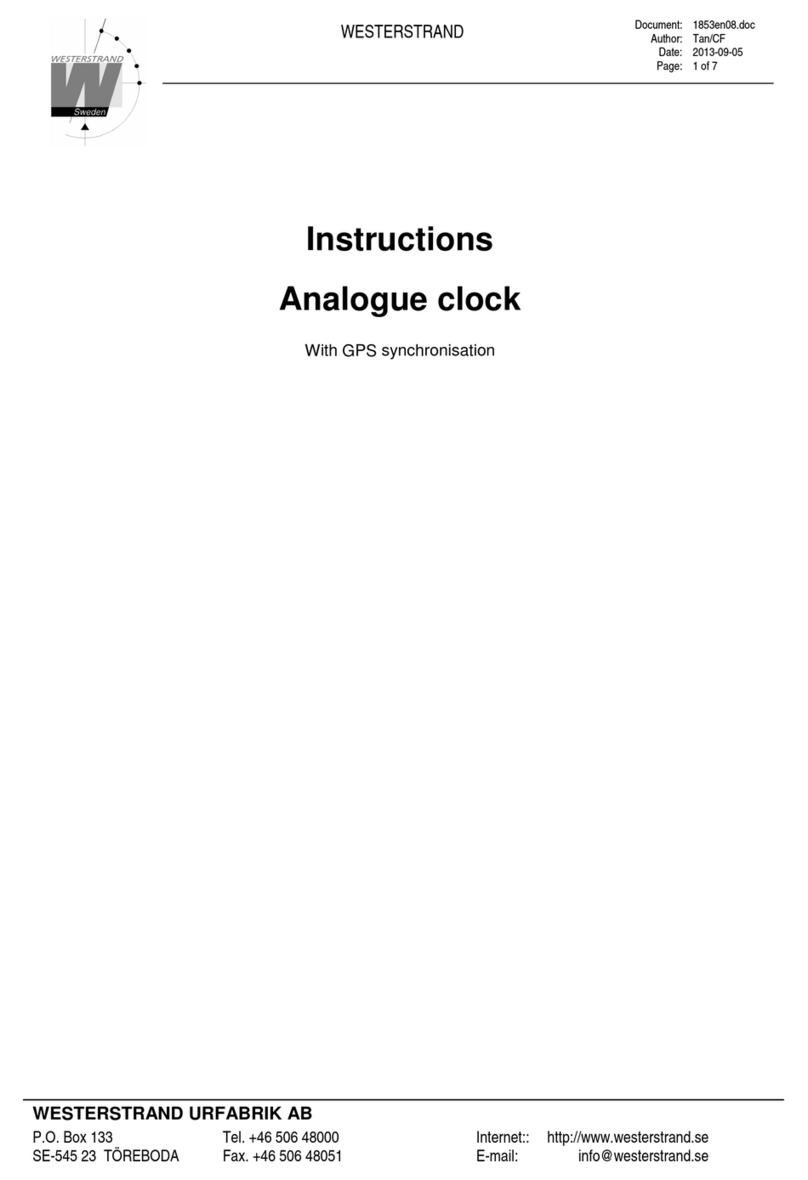
WESTERSTRAND
WESTERSTRAND Analogue clock instructions

La Crosse Technology
La Crosse Technology 513-148 Faqs
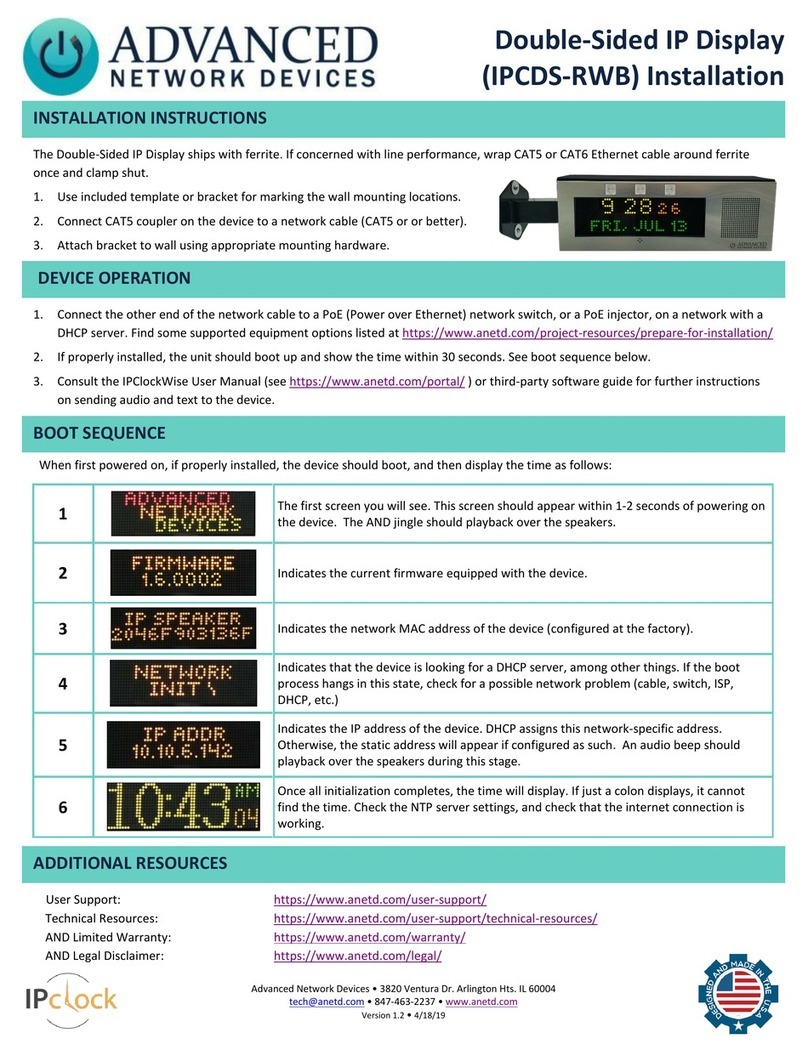
ADVANCED Network Devices
ADVANCED Network Devices IPCDS-RWB installation instructions

Oregon Scientific
Oregon Scientific RM868P user manual
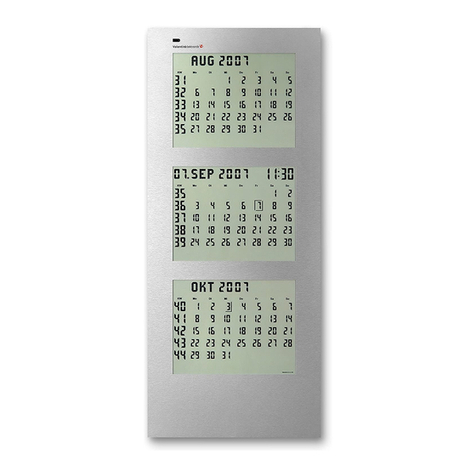
Valentin Elektronik
Valentin Elektronik CK-3 installation manual
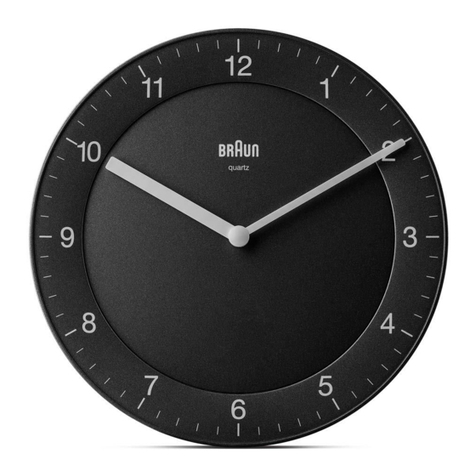
Braun
Braun BC06 User instructions
